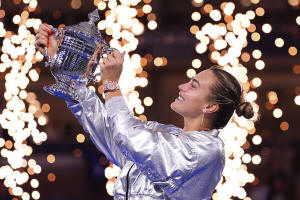Aryna Sabalenka defeats Amanda
Anisimova for her 2nd consecutive US Open title and 4th at a major
[September 08, 2025]
By HOWARD FENDRICH
NEW YORK (AP) — Aryna Sabalenka was two points away from what
eventually would be a second consecutive U.S. Open title when she
had what should have been a routine — easy, even — overhead smash.
Instead, while backpedaling, she dumped the ball into the net,
giving her opponent, Amanda Anisimova, a break chance.
After that excruciating miss Saturday, Sabalenka dropped her racket
on the blue court and smiled a rueful smile. She began to feel the
sort of emotions that got the better of her during losses in the
finals at the Australian Open in January and French Open in June
bubble up. She tried to compose herself.
“I just let the doubt get into my head,” Sabalenka explained. “But
then I turned around and I took a deep breath in, and I was like,
‘OK. It happens. It’s in the past. Let’s focus on the next one.’”
So everything was fine from there? Well, no. “She broke me,”
Sabalenka said with a loud laugh. “I was like, 'OK. ... Reset.”
It took another 15 minutes to complete the job, but the No. 1-seeded
Sabalenka did reset, unlike at those earlier title matches in 2025,
and was able to kneel on Arthur Ashe Stadium's court while covering
her face with her hands after beating Anisimova 6-3, 7-6 (3). That
made Sabalenka the first woman to earn the trophy at Flushing
Meadows in consecutive years since Serena Williams in 2012-14.
“I truly really admire her,” said No. 8 seed Anisimova, a
24-year-old American who heard raucous support from the 24,000 or so
spectators. “She puts in a lot of work, and that’s why she’s where
she is.”

Sabalenka, a 27-year-old from Belarus, earned her fourth Grand Slam
trophy — all on hard courts — and avoided becoming the first woman
to lose three major finals in a season since Justine Henin in 2006.
Sabalenka was the runner-up to Madison Keys at Melbourne Park and to
Coco Gauff at Roland-Garros.
Those defeats helped on Saturday.
“After the Australian Open, I thought that the right way would be
just to forget it and move on. But then the same thing happened at
the French Open," said Sabalenka, who showed up at her postmatch
news conference with a bottle of Champagne and a pair of dark
goggles atop her head. “So after French Open, I figured that, OK,
maybe it’s time for me to sit back and to look at those finals and
to maybe learn something, because I didn’t want it to happen again
and again and again.”
As Anisimova kept making things close again, and the crowd kept
getting loud, Sabalenka reminded herself to focus on herself.
It worked.
[to top of second column] |

Aryna Sabalenka, of Belarus, holds her trophy aftyer defeating
Amanda Anisimova, of the United States, after the women's finals of
the U.S. Open tennis championships, Saturday, Sept. 6, 2025, in New
York. (AP Photo/Yuki Iwamura)

When Anisimova trailed Sabalenka 2-0, 30-love as
Saturday’s match began, some fans might have wondered: There’s no
way there’s going to be a repeat of the Wimbledon, right? That's
because Anisimova's first major final, in July at the All England
Club, ended with a 6-0, 6-0 shutout against Iga Swiatek.
But Anisimova grabbed the next four points to break
back, capping the game with a backhand winner and a forehand winner.
That got folks on their feet, shouting, and Anisimova exhaled as she
walked to the sideline. Soon, she led 3-2.
That was another moment that could have thrown Sabalenka. Nope. She
took the next four games and that set.
It began pouring before the match, so Ashe’s roof was shut and its
artificial lights were on. That was a problem from Anisimova, who
said she had a hard time seeing the ball during serve tosses.
The setup also created windless conditions, ideal for two
ball-strikers who really can bring the power with good contact. And
that’s what they both did.
Some exchanges were breathtaking — to them, certainly, and to those
in the stands who gasped at the power during longer points. The
rewards can be huge, as can the risks, and Anisimova was seeking the
lines with full cuts off both sides.
“I think I didn’t fight hard enough for my dreams today,” said
Anisimova, who buried her face in a towel after the match.
Of Sabalenka’s first 13 points, just one came via her own winner.
The others? Six unforced errors and six forced errors by Anisimova.
By the end, Anisimova had nearly twice as many winners as Sabalenka,
22-13, and nearly twice as many unforced errors, too, 29-15.
“There was two moments where I was really close to lose control,”
Sabalenka said later, “but ... I told myself, ‘No, it’s not going to
happen. It’s absolutely OK.’”
All contents © copyright 2025 Associated Press. All rights reserved
 |